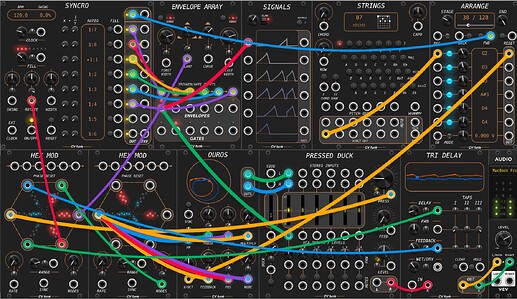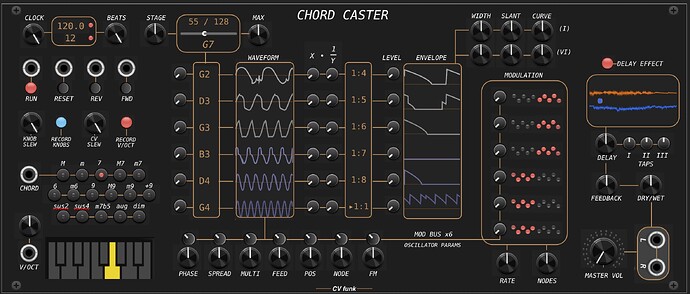This doesn’t appear to be working for me in the current Library build. I used Midi To CV in poly mode, but the outputs remained mono and did not add polyphonic outputs.
Hmm. @auxmux Are you sure you are sending it a poly signal? Poly is a new feature in v2.0.8, which just went to the library today, so maybe you don’t have the latest one? You can always delete the plugin from your user folder and VCV will download the latest library build to replace it. Hope it works for you! ![]()
Thanks, that was it. I wasn’t on the latest betas, but updating to today’s release fixed it.
I found a bug introduced to Strings in the last version 2.0.8. Sorry about that, the trigger out won’t work till I send the patch to the library. In the meantime v2.0.8.1 patch to fix this is live on my github.
Also, here’s a fun little patch demo that shows how you can use Arrange to record and quantize from MIDI inputs:
Also, I added new context menu options to increase the sequence length in Arrange to some longer recording lengths (now up to 2058samples)-- so that you can record with a higher clock multiple and get better resolution in the playback. Additionally another context menu option makes Rec turn off at the end of the sequence so you can now record a single loop. Making this demo made me realize that longer sequences could be handy, so that’s gonna be in the hotfix.
Thanks for the continued work on these.
I’m noticing a bug with Pressed Duck in 2.0.8 (and I think perhaps prior) where sometimes when disconnecting an input channel, the output voltage freezes at a constant DC. Nothing that happens at the inputs gets through anymore at that point, though the DC value scales with the output Level knob. Haven’t found a cure except deleting the module and spawning a new one.
I can’t seem to reproduce this bug. But maybe with some more clues I can trace it to a problem and fix it. I’ll certainly look into it! Thanks for pointing it out for me.
I edited the code of the Ducks a little bit and posted a new update to git. I found a couple places where maybe it could have 0 channels and then do some bad math. Also, zapped an issue where muting a channel wouldn’t decrease the headroom appropriately. Not sure if either of these fixes the issue, but hey a couple more little bugs squashed. ![]()
Oh I think that first one might be it! This came up while “in the flow” so I’m not exactly sure, but it could’ve been that it happened when removing the last channel. And I actually think I may have seen/heard that headroom bug too once. Thanks!
@codyge Been thinking about this, an expander for Synchro that lets you control the probability for each the outputs would be neat. Would add to the generative fun.
New Module v2.0.9
Tri Delay
3-tap delay effect with up to 3.6sec delay time. Feedback adds gentle tanh saturation with anti-derivative anti-aliasing. Stereo outputs are additionally anti-aliased with 8x oversampling and filtering. Each tap can be placed in stereo to the 2 delay tracks, leading to interesting interactions between the taps. Intuitive interactive display.
This is my first effect… and honestly I have no idea what I’m doing here. But it sounds cool! Get metallic sounds by using short delay times, spread the three taps out by a few msec each and pan them left to right so that they don’t overlap too much. With longer delays you can create interesting rhythms. I put a bunch of processing into the anti-aliasing, so it’s a little bit of a CPU hog using a full 2% on my test mac. However I don’t think this type of effect can be made that much more efficient, as the tanh-ADAA and anti-aliasing really helps keep the feedback under control.
Opinions welcome! There are about 100 other delay modules out there and I’m not sure that this is better than any of the others, but I like the interface and find it easy to use. I hope you enjoy it too. ![]()
Can never have too many delays or reverbs. Looking forward to trying it.
Looks wonderful!
Here is a demo patch of V2.0.9
I’ve been thinking of designing a semi-modular next (as a pro module), and this patch is the first prototype of what I’m thinking of. The semi would have a 6-channel Syncro, 6-channel Envelopes, and then 6-channels of Ouros, and 6-channel Duck mixer, all fed through a delay and pre-wired up. There is going to be an interface to play it, something similar to Strings, maybe simpler access to the different chord banks, and 6-channel version of Arrange would record your keypresses into a long loop. 2 different modulation busses, one mid-rate and the other very slow. And everything would be compacted a bit to fit, with many of the ins/outs and controls simplified and made more macro-controller.
My thought is that a semi-modular should reduce the patching necessary to get started, and make it more intuitive to just record something. But I don’t want to over-simply it at the same time… so I’ll add some twists to spice it up of course. And it’ll have a new interface and display of what’s going on inside… probably. I’ll have to draw it out first to see how many knobs and things we can really fit.
Here is a first draft of the semimodular layout. It’s a confusing disaster…
After making this I realize it needs to be a lot simpler. I think the next iteration will have 6 rows of channels going left to right, so the signal path is more apparent. The keys will be on the left side instead of in the middle. And also the modulation bus will need to be re-imagined, either as a matrix with buttons, or maybe like that mini cartoon I drew with trimpot knobs to assign each LFO to a list of inputs.
Thinking more about the semi-modular design… Here is version 2 of the design. I’m getting a bit more settled on the basic workflow, but details like how the clock/stage advancing will work together are still foggy.
The goal is to end up with a layout that is totally self explanatory and has an obvious workflow where it’s super clear what’s happening in each part of the synth. Also it needs to have enough internal/external modulation options to sound interesting at the same time.
Also, see that there is a serious lack of CV inputs here… there just isn’t space for all those attenuverters and jacks. I might add some more CV inputs in the next iteration of design… Or maybe I’ll add a small patch bay or expander that has inputs… I’m not sure yet. Ideas welcome.
Exactly the use case for extenders. It would be nice if it could sit below in the rack and not only to the side, because of the length. It is possible to do this (I do iit n HC One) but you don’t have the help of the Rack API.
I have been thinking about vertical expanders as well. Determining shared horizontal borders sounds kind of ugly, because it could be a many to many relationship. For my Venom Bypass I effectively link modules via a cable. The cable does not have to be used to transmit voltages - it can simply be used to specify which modules are linked. I have some modules in mind where it would be really handy to have vertical expanders in addition to horizontal, and I think the cable method could be very effective. It could be used for remote links as well.
@codyge Sorry about hijacking your thread.
Regarding external CV modulation - I think something like the Surge-XT design would be really effective where you can assign multiple destinations for the input, with independent attenuversion for each.
The cable for establishing a connection is a nice UI. I don’t expect Rack to ever have vertical extenders. Instead of only left/right, you’d have an open-ended list of adjacent modules. Even then, I don’t care for the restriction to adjacency. Physical Eurorack doesn’t have that limitation for back-connected modules. Back to my earlier wish for data cables ![]()
Okay. Here’s try #3 at an interface design
The new idea is that at each stage it can record the V/Oct CV of each of the 6 channels, and also the position of all the knobs. You can turn on/off recording with some buttons that are arranged in a transport.
The two slew controls configure how fast the V/oct and param knobs go to their programmed position when you change the stage.
I removed some extra stuff like the guitar chord fingering, and the saturation/distortion controls etc. Fewer controls, and thus just a bit more focused even if it’s more limited.
I still need to think of a good way to sync up this thing with other clocks, so on the top right there could be some other in/outs for clock syncing and sending a reset trigger out.
In the modulation box, I’m still deciding how that’ll work. Right now it’s like HexMod but with an attenuverter on each of the 6 channels. Then those get stacked into a poly signal that is sent to attenuverters for Ouros knobs at the bottom.
At the top left, Clock sets the internal clock rate, and Beats sets how many clock pulses per stage, so it’s basically a master clock divider that controls the stage advancing.
Gotta say, Ouros has been incredibly useful to create deep bass sounds, and with some slight modulation of the v/oct it can start to live a very nicely.
Version 4 of the prototype layout.
I’m trying to simplify the interface design, while making the functions more usable. This is just a cartoon by the way, I’ve not even dared write any code for this yet until I nail down the plan.
The idea here is that each stage of the sequencer it lets you record both the notes and the knob positions, set with the record buttons at the top.
You enter in a note/chord combo, and it stores it to the column of notes. You can adjust individual notes in the resulting chord with the knobs to the left of each one. Each stage you can also adjust the knob positions and it stores that as well, so you can have different oscillator settings, clock divisions/multiples, envelope shapes, and delay settings set for each stage.
When the clock is running it recalls the notes and knob positions, and you will have slew control over both separately. So you can slew the knobs but not the notes, or slew notes but not knobs…
I added a copy/paste buttons, hopefully to make it easier to program. I don’t want to overcomplicate the interface, but copy/paste seemed a reasonable quality of life addition.





